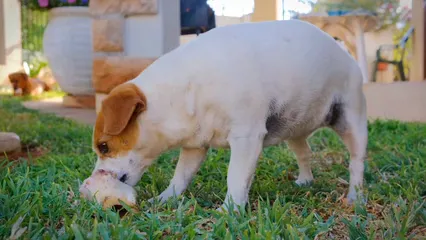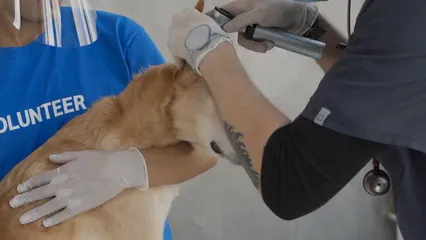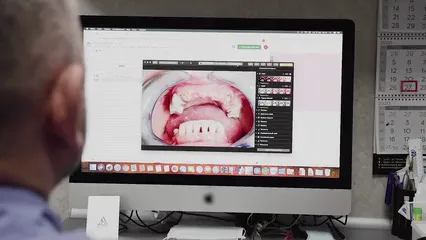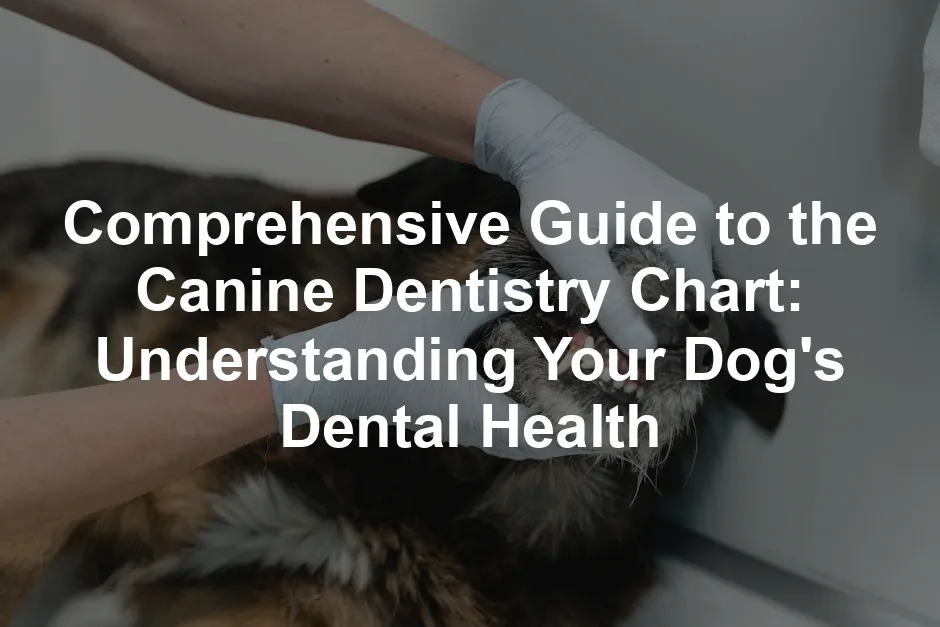Introduction
Dental health is crucial for your dog’s overall well-being. A canine dentistry chart helps both pet owners and veterinarians track dental conditions effectively. This article aims to educate you about the canine dentistry chart and its significance in maintaining your dog’s dental health.
For a deeper understanding of how dental health relates to statistical learning, check out an introduction to statistical learning with python book length.
Summary and Overview
A canine dentistry chart is a valuable tool used in veterinary care. It records the condition of a dog’s teeth, helping to identify any abnormalities. Understanding the anatomy of a dog’s teeth is essential for effective dental care.

Dogs have four types of teeth: incisors, canines, premolars, and molars, each serving a specific function. Regular dental care is vital to prevent issues like periodontal disease.
Veterinarians use the chart during examinations to document findings and plan treatments. In this article, we’ll cover the different types of dog teeth, how dental charting works, and tips for maintaining your dog’s dental health.
Speaking of dental care, you might want to consider using a Vet’s Best Enzymatic Dog Toothpaste. It’s designed to fight plaque and tartar while freshening your pup’s breath. Because let’s face it, nobody wants to cuddle with a dog that has dragon breath!
Understanding Dog Dental Anatomy
Types of Teeth in Dogs
Dogs have four main types of teeth, each with unique purposes.

Incisors are the small teeth at the front. They help scrape food from bones and groom fur.
Next, we have the canines, which are long and pointed. These teeth are essential for tearing meat and gripping objects.
Premolars are located behind the canines. They have sharp edges that shred and chew food, especially meaty items.
Lastly, the molars sit at the back of the mouth. These are used to break down hard foods like kibble and biscuits. Understanding these types helps you appreciate your dog’s dental needs.
To assist in keeping those teeth clean, check out PetSafe Healthy Mouth Dog Water Additive. This magical potion can help support your pup’s dental health while they hydrate. It’s like a spa day for their mouth every time they drink!
How Many Teeth Do Dogs Have?
Adult dogs typically have 42 teeth. This includes 20 teeth on the upper jaw and 22 on the lower jaw.
The breakdown is as follows: 12 incisors, 4 canines, 16 premolars, and 10 molars.
In contrast, puppies have 28 teeth when they grow all their milk teeth. This set consists of 12 incisors, 4 canines, and 12 premolars.
Puppies lose their baby teeth by about six months, transitioning to their adult set. Knowing this structure is vital for monitoring your dog’s dental health.

Canine Dental Chart: What Is It?
Purpose and Importance of the Canine Dental Chart
A canine dental chart is a vital tool in veterinary care. It serves to document the condition of each tooth during examinations.
This chart helps veterinarians identify any dental issues, such as decay or periodontal disease. By tracking changes over time, vets can diagnose problems early.
Moreover, pet owners can use the chart to note any concerns at home. Understanding this tool enhances your ability to care for your dog’s dental health.

For a more interactive approach to your dog’s dental health, consider a Dog Training Clicker. It can help reinforce good behavior during dental care routines, making it a fun experience for both you and your furry friend!
How the Canine Dental Chart Is Structured
A canine dental chart is designed to provide a clear overview of your dog’s dental health. Typically, it includes each tooth’s position, condition, and any abnormalities observed. The chart is structured to ensure that veterinarians can efficiently document findings during examinations.
One key aspect is the modified triadan system. This system allows for standardized tooth identification. Each tooth receives a unique three-digit number. The first digit indicates the quadrant of the mouth, while the next two digits specify the tooth type. For instance, a tooth numbered 202 refers to the left upper canine. This system helps in maintaining consistency in dental records, making it easier to track changes over time.
By understanding this structure, pet owners can better grasp their dog’s dental health and the significance of any noted issues.

How Veterinarians Use Canine Dental Charts
During Oral Examinations
When veterinarians conduct oral examinations, they rely heavily on the canine dental chart. The process begins with a visual inspection of the mouth and teeth. The veterinarian checks for any signs of dental disease, such as plaque buildup or gum inflammation.
As they examine each tooth, they document their findings directly on the chart. This record includes notes on any abnormalities or concerns. Documenting these findings is crucial, as it creates a comprehensive history of the dog’s dental health. This way, future visits can build on previous records, allowing for more accurate diagnoses and treatment plans.

To keep your dog entertained while you focus on dental care, consider a KONG Classic Dog Toy. It’s perfect for keeping your pup busy while you tackle their dental routine!
Charting Dental Health and Disease
Dental charts play a vital role in tracking periodontal disease in dogs. They help veterinarians assess the extent of gum disease and tooth decay. Various indices are used in veterinary dentistry to evaluate dental health. For example, the Periodontal Disease Index measures the severity of gum disease.
This index ranges from healthy gums to advanced periodontal issues. By using these indices, veterinarians can effectively communicate the severity of a dog’s dental condition. This aids in formulating treatment plans and monitoring progress over time. Keeping meticulous records through dental charts ultimately leads to better dental care for your furry friend.
Tips for Maintaining Your Dog’s Dental Health
At-Home Dental Care
Keeping your dog’s teeth clean is essential. Regular brushing helps prevent plaque buildup. Use a toothbrush and toothpaste made for dogs. Human toothpaste can harm your pet, so stick to dog-safe products.
Incorporate dental chews into their routine. These tasty treats can help reduce tartar and plaque. Look for products endorsed by the Veterinary Oral Health Council for the best results.

Additionally, consider dental water additives. These can freshen breath and promote oral health. Always supervise your dog with new toys or treats to ensure safety.
For dental chews, you can’t go wrong with Arm & Hammer Dog Dental Chews. They’re not just tasty but also work wonders in keeping your dog’s teeth healthy and clean!
Regular Veterinary Check-ups
Regular visits to the vet are key for your dog’s dental health. Schedule dental check-ups at least once a year. Your veterinarian will examine your dog’s teeth and gums, checking for signs of disease.
Common treatments during these visits may include professional cleanings and extractions if necessary. These procedures help prevent more serious issues from developing. If you notice any changes in your dog’s eating habits, don’t hesitate to consult your vet. Early detection can save your pet from pain and discomfort.

And speaking of professional cleanings, why not pamper your pup with a Dog First Aid Kit? It’s always good to be prepared, especially when it comes to your fur baby!
FAQs
What is a canine dentistry chart?
A canine dentistry chart is a specialized tool used by veterinarians. It records the condition of each tooth during dental examinations. This chart helps identify dental issues like cavities or gum disease. By tracking changes over time, vets can diagnose problems early. Pet owners can also use it to monitor their dog’s dental health at home.
How many teeth do dogs have?
Adult dogs typically have 42 teeth. This includes 20 teeth on the upper jaw and 22 on the lower jaw. The breakdown is: 12 incisors, 4 canines, 16 premolars, and 10 molars. In contrast, puppies have 28 teeth consisting of 12 incisors, 4 canines, and 12 premolars. They lose these baby teeth around six months, transitioning to their adult set.
Why is dental health important for dogs?
Dental health significantly impacts your dog’s overall well-being. Poor oral hygiene can lead to periodontal disease, which affects the gums and bone. Nearly 90% of dogs show some degree of periodontal disease by age 3. This can result in pain, infection, and even systemic health issues. Healthy teeth contribute to better eating habits and a happier life.
How often should I take my dog for dental check-ups?
Most veterinarians recommend annual dental check-ups for dogs. However, younger dogs or those with dental problems may need more frequent visits. Regular check-ups help catch issues early and prevent more serious conditions. If you notice changes in your dog’s eating or chewing habits, consult your vet sooner.
What are common dental problems in dogs?
Common dental issues include periodontal disease, broken teeth, and tooth decay. Periodontal disease is the most prevalent, often leading to gum inflammation and infection. Broken teeth can occur from chewing hard objects. Regular dental care, including brushing and vet check-ups, can help prevent these problems.
Please let us know what you think about our content by leaving a comment down below!
Thank you for reading till here 🙂 And don’t forget to treat your pup with Zuke’s Z-Filets Dog Treats. Because who doesn’t love a tasty reward after a dental check-up?
All images from Pexels




